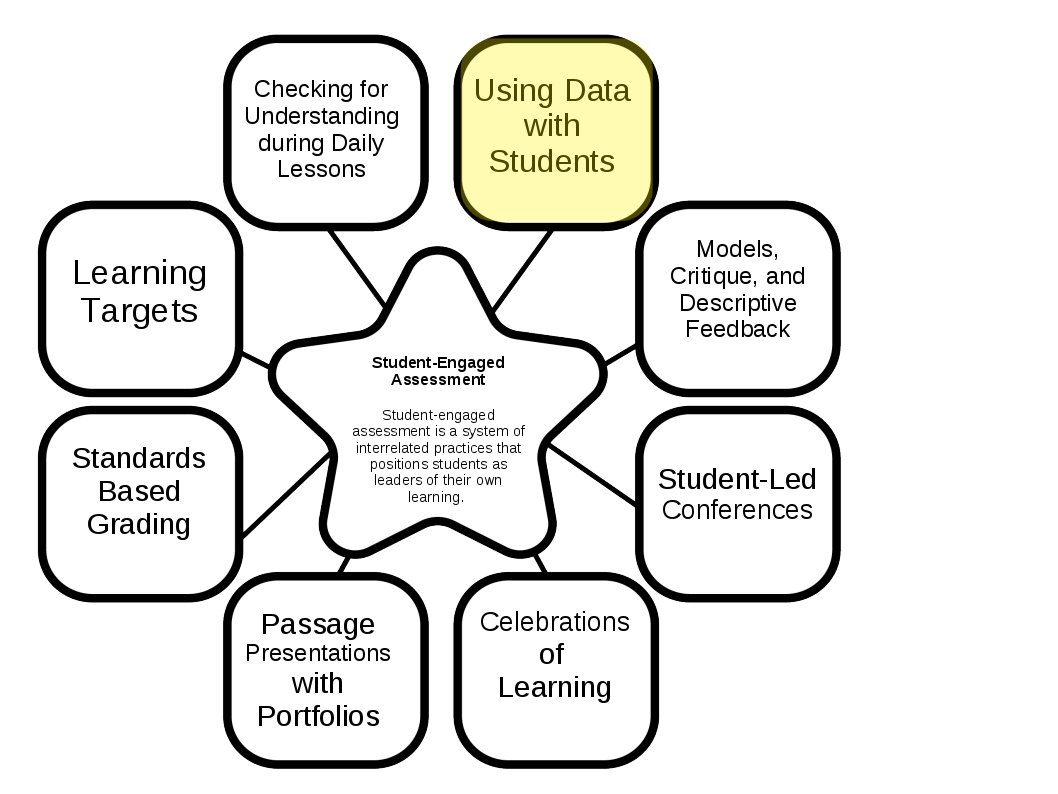Leaders of Their Own Learning

Chapter 8: Standards Based Grading
- Standards-Based Grading
Purpose is to communicate about student achievement toward well-defined learning targets. Grades are not for motivation or punishment, they must accurately describe student's progress and current level of achievement. Habits of scholarship are graded separately from academic content, and student engagement is key to the grading process.
Why this Practice Matters
Communicating Clearly about Achievement
Engaging Students
Holding Students Accountable
Getting Started
Building on a Foundation of Student-Engaged Assessment Practices
Using Learning Targets to guide curriculum, instruction, and assessment
Using clearly defined habits of scholarship which reflect the school's code of character with specific, evidence-based skills and actions
Laying the Groundwork with a Faculty Grading Guide
Ensuring that all grades and subjects have prioritized standards and powerful learning targets
Developing a common language and definitions for proficiency on learning targets
Determining progress toward long-term learning targets
Calculating grades at the end of the term
Reporting on habits of scholarship
Identifying the support structures or processes for students who do not meet or exceed their learning targets
Prepare and Support Teachers
Dedicate significant professional development resources and ample time to take in the principles and practices of their new grading paradigm
Develop school-wide habits of scholarship and structures to track student progress toward meeting them
Support teachers in setting up grade books by long-term learning targets rather than by assignment or assessment
Develop a report card that is standards based and includes character learning targets
Prepare and Engage Students
In order to engage students in the grading process, teachers need to teach them how to understand learning targets, how to be good trackers of their own progress based on assessment information, and how to identify next steps and goals to help them reach the targets.
Communicate with Families and College Admissions Offices
In Practice
Ensuring a Comprehensive Approach to Standards Based Grading
Reviewing and Refining Standard-Target-Assessment Plans to Ensure Quality
Revision Checklist for Quality Assessment Plans
- Standards and Learning Targets
Do the standards and learning targets align with each other?
Do the learning targets meet the criteria for quality?
Standards-based, one clear verb, identify the intended learning, divided into long-term and supporting targets appropriately
Are targets written in student friendly language with an "I can" stem?
Are there a variety of kinds of learning targets?
Reasoning, Knowledge, and Skill
Do knowledge and skill learning targets prepare students for reasoning targets?
Are content, literacy, numeracy, and character all accounted for?
- Summative Assessments and Assessments of Learning
Are there multiple opportunities for students to do on-demand assessments and demonstrate mastery of each long-term learning target?
Is there clarity around the assessment tool to be used for assessments of learning? - Rubrics, Criteria, Checklists, Tests
Do the learning targets and assessment methods align with one another?
Are assessments varied in format and type?
Are the assessment experiences designed to motivate and engage students?
Have you included smaller assessments that can be used with students in formative ways?
Are assessments designed to support student success on state assessments aligned to the Common Core?
- Formative Assessments
Do assessments for learning dominate the assessment plan with assessments for learning opportunities for each supporting learning target?
Do your assessments for learning practices prepare students in form and content for culminating assessments of learning?
Have you attended to a variety of learning styles in the range of assessments for learning opportunities you have provided students?
Are assessments for learning experiences crafted to maximize student motivation?
Do assessments for learning provide students with a clear vision of the learning targets and ensure regular opportunities for descriptive feedback?
Do assessments for learning strategies involve students through self-assessment, peer revision, and reflection at regular intervals?
Refining School-Wide Structures and Staffing Roles to Help Students Who Need Additional Support
Intensives in Secondary Schools
Courses lasting 4 to 8 full school days during which students are engaged in either an in-depth study of a topic or intense, targeted academic support in areas where learning targets have not been met.
Other Support Structures
"Block 7" extended day
Saturday Classes and tutorials
Acceleration Programs
Defining Roles of Learning Specialists
Summary
Standards-Based Grading is the culmination of all the steps in the student-engaged assessment progress. If we develop quality learning targets and use those to guide our teaching, then we can check for understanding daily by having the children self reflect and process their learning. Then we can use those formative checks to collect data to share with students to help them make goals about their learning targets. We can then use models and feedback to give them a sample to reach towards and exceed. When students do these things, they will be able to share their learning through student-led conferences as well as celebrations of their learning and passage presentations with portfolios. When all these pieces are in place, you and the student can show evidence for each standard/learning target to show their mastery.
This is something that would have to be implemented school-wide. I can see it being used to grade some of the work within the classroom, however if your school has a report card that just shows grades, then it would be hard to transfer that information. I can see implementing the "ideals" of standards-based grading when using portfolios and I think that is where I will start.
Check out other chapters by clicking on the links below:






